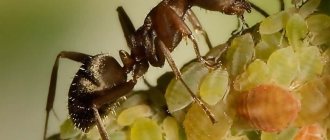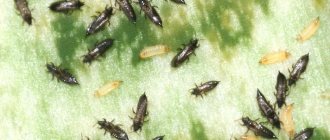5
(1)
Speedwell filamentous or filamentous is a plant with soft blue or white small flowers, which often greatly bothers owners of summer cottages. Indeed, it is aggressive in its vitality and almost invincible - it quickly clogs not only paths, lawns, flower beds, but also vegetable gardens. On the one hand, this vitality and indomitable energy can be put to good use, on the other hand, it greatly interferes with useful plantings and is considered one of the most annoying weeds. In this article we will tell you how veronica filamentous is destroyed on the lawn in various ways.
Features of filamentous speedwell
It has thin, creeping, easily rooted shoots, which is why it is considered an aggressor plant. She does not like wet soil, but will survive well both on it and on dry soil during the hot summer. When frozen, it is easily restored.
Veronica filamentous or filamentous - this is what this plant looks like
The description and characteristics of Veronica filamentous are presented in the table:
| Characteristics | Description |
| Plant type | herbaceous |
| Family | Norichnikovye |
| Decorativeness | decorative flowering, ground cover |
| Soils | fertile, moderately fertile, poor, drained, sandy loam, waterlogged, clayey, loamy |
| Soil moisture | dry, wet, moderately wet |
| Lifespan | annual, biennial, perennial |
| Illumination | partial shade, direct sunlight |
| Reproduction | seeds, cuttings, division |
| Boarding time | Spring Summer Autumn |
| Distribution area | Western and Southern Europe, Caucasus, Iran, Asia Minor |
If you do not get rid of Veronica filamentous in time, it can completely take over your garden. It is a low-growing plant with tiny, rounded leaves and charming flowers that close in bad weather. It's almost useless to fight her. She takes care of herself and easily wins the fight against other weeds.
If you want to get rid of it, then thread-like speedwell can be removed from the site along with the thin top layer of soil, without leaving a single shoot. If it has not grown too much, it can be weeded by hand. As a last resort, you will have to resort to the use of selective herbicides.
However, it is so attractive in appearance that, for example, it can be planted among fruit trees and shrubs. Here it does not interfere with cultivated plants. But in the spring it decorates the earth with its color. Moreover, speedwell prevents the soil from compacting and drying out.
Pest protection
Veronica planting and care photo Veronica surculosa
Due to its natural endurance, Veronica is rarely affected by infections. Waterlogged soil or a shady area of the garden can provoke the appearance of downy mildew (a gray coating on the leaves). For treatment, a fungicidal solution is prepared from the preparations Fitosporin, Alirin-B, Gamair.
Eliminating the diseased plant and treating the flower bed with nematicides will help fight the ring spot virus. The carriers of the virus are nematodes that live in the soil. Yellow, curled foliage is a sign of soil damage by nematodes, and the plants have ring spot.
Among insect pests, you can most often find caterpillars that eat foliage and young shoots. Warming up the soil, timely weeding, and a break in watering will save you from them. Less common are cutworms, moths, and long-whiskered moths, which can be treated with insecticides.
How to deal with Veronica filamentous on the lawn
Despite its “angelic” appearance, the delicate filamentous veronica is still a serious enemy of the lawn. Rapidly spreading, it is capable of killing lawn grasses, capturing more and more new areas. And at the same time, it reacts weakly to herbicide treatment.
How to deal with it? In what order? First of all, it is worth observing how the lawn grass itself feels, the types and varieties of which must be carefully selected. If there are voids and bald spots between the shoots, then the weed will definitely settle in them. Then you need to understand what the herbs need and what the weed prefers.
Description and characteristic features
A low perennial (up to 7 cm) covers the free area with a thick carpet woven from thin, easily rooted stems. Refers to ground cover species. Numerous small leaves have a rounded shape and a light green color.
Mass flowering is observed from late spring to mid-summer. The plant carpet is covered with blue and blue or white patches of small flowers, which open together in large numbers. Interestingly, in inclement weather the flowers are closed.
Veronica filamentous is undemanding to placement conditions. Preferring damp places with light shade, it can grow remarkably well both in full sun and in constant shade. It tolerates short-term dry weather disasters without problems.
When placed under fruit trees (apple, pear, cherry, blackthorn, various currant bushes), it exists perfectly on its own and protects its neighbors. Thanks to the created carpet, Veronica filamentous maintains the moist state of the soil under its shoots, which is important for cultivated trees and shrubs. At the same time, it does not deplete the soil.
Thus, the trees and bushes under which the growing speedwell filamentous vegetation is located are protected from drying out and compacting the soil. The herbaceous guest has also proven itself in use on alpine hills or for flower borders. However, there is a downside to good survivability.
If left uncontrolled, ornamental speedwell can turn into a feral, malicious weed - an aggressor for garden beds. To avoid such a situation, a little attention and effort is required: proper maintenance, restriction of free reproduction.
How to fight Veronica filamentous with herbicides
Gardeners often make mistakes: they treat weeds at the wrong period of development, select the wrong concentration or time of day. Weeds are most sensitive to herbicides in the spring growth phase. Resistance to them increases sharply during flowering and seed ripening - at this time, herbicides have no effect on speedwell, like other weeds.
However, Veronica is already quite resistant to most drugs. At first glance, the first treatment has practically no effect on it. But in fact, its growth stops. And with subsequent treatments, its amount is significantly reduced.
This is what weed flowers look like close up
If you have just begun to develop the area, then before sowing lawn grass, glyphosate-based products are very effective in controlling speedwell and its extermination - Tornado, Hurricane, Round-Dup, etc. Later, when the lawn is already in the stage of active growth, preparations are used Lontrel, Dicamba, Lintur, which also stop the growth of the weed. Veronica is most sensitive to herbicides during the period of bud formation - then the treatment is very effective.
When working with herbicides, it is important to act strictly in accordance with the recommendations for the concentration of drugs and their consumption over a certain area. If the instructions indicate that one ampoule should be dissolved in 3 liters of water and treated with the resulting solution on 1 hundred square meters, then you should not try to spray 2 or even 3 hundred square meters with this amount. On the other hand, you shouldn’t make a stronger solution in the hope that the effect will come faster. All deviations from the rules are fraught with unpredictable consequences.
The main thing is that your lawn grows in normal conditions, that it is properly cared for, and that the grass is most suitable for your site. Then, in order to get rid of “uninvited guests” - filamentous speedwell and other weeds, one or two hand weedings at an early stage of their appearance will be enough for you.
Agricultural technology
The plant is unpretentious, so special skills in growing these flowers are not required. Veronica filamentous (or creeping) is able to adapt to growing in any conditions. The grass is unpretentious to soil. Most types of veronica are moisture-loving plants, but they take short-term drought calmly and easily tolerate it.
In Russia, the plant easily survives, being frost-resistant and easily tolerating the harsh Russian frosts. Although some of the species are more delicate, for example, Veronica branched. There is a need to cover them with spruce branches for the winter.
Why do weeds appear on the lawn?
Veronica filamentous, like other creeping weeds, reproduces well on a lawn with thinned grass. To determine the level of activity of these weeds, before mowing, it is recommended to comb the lawns for some time, lifting the lashes with a rake. This will help to capture weeds during mowing, while simultaneously stimulating the tillering of lawn grass.
Weeds on the lawn are quite common. This problem occurs for several reasons:
- due to improper preparation of the area;
- due to illiterate selection of lawn mixtures;
- due to poor care.
Removing weeds is the number one task for every high-quality lawn. Indeed, when weeds appear, its decorative appearance significantly deteriorates. Lawn grasses lose their characteristic bright green color, become depleted, and begin to grow poorly. In the absence of proper care on a neglected lawn, weeds quickly crowd out delicate lawn grasses, so the fight against them must be carried out continuously.
The main source of weeds is the soil in which weed seeds are hidden. Why is removing weeds from your lawn so important, and how can they harm your lawn? The main thing is that weeds spoil the decorative appearance of the lawn, making it unkempt and unkempt. In addition, weeds draw moisture and nutrients onto themselves, preventing lawn grasses from developing normally. Because of this, lawn coverings degenerate and die.
Tip #2. It is also necessary to fight weeds on the lawn to prevent the development of various diseases on it, which are sometimes very difficult, if not impossible, to cure.
Weeds must be removed from the lawn, because they can bring a lot of different diseases and pests to
the lawn. Weeds can lurk in the soil for many years without losing their germination capacity, and they germinate when placed in favorable conditions. They quickly begin to make themselves felt if, for example, organic fertilizers get into the soil during the creation of a lawn. After all, birds can also carry weed seeds onto the site.
Basics of care
Excellent adaptability to any living conditions saves physical and time costs for both an experienced gardener and a beginner. The main actions to maintain decorativeness and prevent wildness are:
- When determining the planting site, artificially created fences along the perimeter of the growing area. This can be a decorative plastic border, a low (10 centimeters) stone or wicker wall.
- Periodic weeding among the planted specimens will prevent excessive thickening and, as a result, spread beyond the “fence.”
- Trimming excess, dried or weakened shoots at the end of the flowering period. Will help preserve the decorative appearance of the plant.
- Applying fertilizing when placing flowering vegetation on low-quality soil. Organic fertilizer is applied once every two years. It can be any type of manure or humus. Fertilizing should be done in early spring.
Agrotechnical methods of weed control
The most effective method of controlling weeds on lawns is hand weeding. The first time it should be done about 20 days after you sowed the lawn, when the root system of the weeds is still quite poorly developed. If perennial weeds appear on the lawn - dandelion, field sow thistle, etc. - they are dug up along with the root system.
Perennials are the most durable weeds. They are dug out with a narrow scoop or knife. In this case, the root systems of the weeds are buried as deep as possible. Manual weeding is a rather labor-intensive process, but it often turns out to be the most effective. After this, the damaged soil must be thoroughly compacted and watered.
Regular lawn mowing is also an effective way to get rid of weeds on lawns. For example, annual weeds can be completely destroyed with regular lawn mowing.
Reproduction
If you do not decide to remove the inflorescences, Veronica will set seeds and produce abundant self-sowing. However, the offspring obtained in this way may not retain the varietal characteristics of the mother plant. If you need a specific variety, it is better to buy seeds from a reliable seller or purchase ready-made seedlings.
Growing from seeds
Veronica seeds can be sown directly into the ground at the end of spring (late May - June) or under film, in a greenhouse at the turn of April and May (in the summer we transplant them to a permanent place). Seeds do not require particularly high temperatures for germination. They will begin to appear in about 2 weeks. When sowing, do not cover the seeds with soil; press them down a little.
Since speedwell seeds are very small, the seedlings should be pricked and the crops in the bed should be pierced so that they do not become too thick (recommended spacing is approximately 25-30 cm).
Propagation by cuttings
You can cut cuttings from shoots, which, after rooting in water or a damp substrate, are planted in a permanent place (before the first winter, it is recommended to sprinkle them, for example, with straw or grass).
Timing for collecting cuttings:
- cuttings of low species are cut in August-September;
- tall - in April-May.
Cuttings should be taken from healthy plants and should be 10 cm long. After removing the lower leaves, dip the tip in rooting agent and then plant. Cuttings should take root within 20-30 days. After rooting, we plant the seedlings in the ground.
Before the first winter, it is recommended to cover them with agrofibre.
Dividing adult plants
Division is carried out in early spring or after flowering (April-June). Typically, division is carried out immediately after digging up the perennial. We divide the plant into parts so that each has several growing points. Then we shorten the leaves and roots and plant the plants in a permanent place in open ground, watering them abundantly.
Chemical methods of weed control
Chemicals produced to kill weeds are called herbicides. Today, selective action drugs (Lontrel-300, etc.) are used to control weeds on lawns. Their peculiarity is that they have a selective mechanism of action that suppresses weed growth, while the lawn remains intact and unharmed.
Tip #3. You can completely clear your lawn of weeds, in particular its above-ground part and root systems, by using such a popular drug as Magnum.
Chemicals are used in warm, windless weather when the grass is dry. This enhances processing efficiency. Before using any medications, you need to carefully read the instructions. After using herbicides, do not rush to mow the lawn - you can resume this procedure and do it regularly only a few days after spraying. If necessary, re-processing must be done after some time.
However, many people use this weed to decorate their garden plots, instead of large carpet flower beds and even instead of the lawns themselves.
Seeds
The material is sown in late autumn. Flowering occurs 24 months after planting Veronica filamentous plants. In the case of spring sowing, seeds are amenable to stratification - a procedure that consists of creating an artificial temperature difference necessary for normal seed germination.
The process of growing a plant from seeds looks like this:
- Prepare a garden pot with drainage substrate.
- The seeds are laid out on the surface, sprinkled with a small amount of soil on top.
- The crops are sprayed with water. The top is covered with a film with small holes that allow the seeds to gain access to oxygen.
- The pot with planting material is placed in a cooler place in order to create special conditions for seed germination (for example, in the refrigerator), where it is kept for the next 3 weeks.
- After this period, the container is moved to a well-lit, warm place and wait for the first shoots, which begin to hatch 2 weeks after the temperature change. Care for seedlings using the standard method.
Veronica filamentous seeds are freely available and can be purchased at any specialized store.











